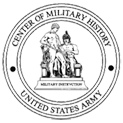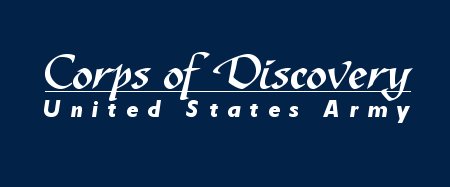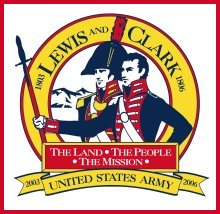The U.S. Army and the Lewis & Clark
Expedition
Part 6: Fort Mandan to the Pacific
While at Fort Mandan, the Corps of Discovery continued its association
with the Indians. The soldiers took part in Indian hunting parties and
social events and built goodwill by providing rudimentary medical care
and the services of their blacksmith, John Shields, to the tribes. They
took time to speak with British and French-Canadian traders who were
well established with the Indians, and gained valuable intelligence.
On 27 October, they hired Rene Jessaume as an interpreter with the Mandan.
A week later they recruited French-Canadian fur trader Baptiste Lepage
into the permanent party to replace Private Newman, who had been “discarded”
from the expedition for “repeated expressions of a highly criminal
and mutinous nature.” Then they hired another French-Canadian fur
trader, Toussaint Charbonneau, as an interpreter. The 44-year-old Charbonneau
had been living and trading among the Hadatsa for the past five years
and had been active on the Upper Missouri since at least 1793. Later,
in March 1805, Lewis and Clark hired Charbonneau to accompany the expedition
west and agreed that he could bring along his young Shoshone wife, Sacagawea,
who had given birth a month earlier to a boy they named Jean Baptiste.
On 6 April 1805, Lewis and Clark sent the keelboat back to St. Louis.
In the keelboat were Corporal Warfington; six privates (including Newman
and Reed, who had been discharged from the expedition for desertion);
Gravelines, the pilot and interpreter; two French-Canadian traders;
and an Arikara chief returning to his village. The next day the remainder
of the Corps of Discovery departed the Mandan villages in two pirogues
and six dugout canoes heading north. Along the way west, the Expedition
continued to note abundant plant and wildlife. The scenery was stunning,
and spirits were high. On 14 April Clark saw his first grizzly bear.
Eleven days later the Corps reached the mouth of the Yellowstone River
and camped there. On 10 May the men saw their first moose. A week later
Clark noted in his journal that the men were beginning to be use deerskins
to make moccasins and leggings, as the original uniform trousers were
wearing out.
Lewis and Clark faced their first major navigational test on 2 June
1805. Arriving at the junction of two large rivers, the captains
needed to decide correctly which fork was the Missouri. Between 4 and
8 June, Lewis and a party reconnoitered the northwest branch, which
Lewis later named the Marias River, while Clark and another group explored
the southwestern branch. After comparing their notes, reevaluating their
intelligence, and studying the maps they had brought from St. Louis,
Lewis and Clark determined that the southwestern branch was the Missouri
River, even though all their men thought otherwise. Nevertheless, in
a great tribute to their leaders, the men followed Lewis and Clark,
although they believed the captains were wrong. Then, on 13 June, Lewis
saw a majestic sight: the Great Falls of the Missouri River. The captains
had been right. Here, the Corps of Discovery made camp and prepared
for the great portage.
Lewis and Clark were proud of their men. The Corps of Discovery was
“zealously attached to the enterprise, and anxious to proceed.”
Indeed, as Lewis wrote, there was not “a whisper of discontent
or murmur” among the men, who acted in unison and “with the
most perfect harmoney [sic].” That the Corps of Discovery was a
tough, resourceful, and tightly knit group was due to the great leadership
of the two captains, who complemented each other so well and had molded
their troops into a confident and cohesive force. They would need that
confidence and cohesiveness during the arduous eighteen-mile portage
around the Great Falls. Over the next three weeks, the Corps of Discovery
struggled up steep slopes, over prickly pear cactus thorns and jagged
ridges, around gullies and ravines, in the scorching summer heat to
complete their passage of the falls. The expedition rested for two days
and continued the journey on 14 July.
On 12 August, the Corps of Discovery reached the source of the Missouri
River. The next day an advance party of Lewis, Drouillard, and two privates
encountered the Shoshones. Using friendly hand signals and gifts, the
soldiers managed to win the trust of the Indians. Four days later Clark
and the rest of the Corps of Discovery joined Lewis and established
Camp Fortunate. At the council that evening, Sacagawea was there to
interpret. But before the meeting began, she recognized the Shoshone
chief Cameahwait as her brother. She immediately embraced him. Lewis
wrote that the reunion was “really affecting.” More gifts,
promises of future trading, and the good fortune that the chief of the
Shoshones was the brother of Sacagawea enabled the party to secure horses
and guides for the journey along the Continental Divide and over the
rugged Bitterroots to the country of the Nez Perce Indians. The hard,
forced march across the Rockies along the Lolo Trail, where the freezing
cold and lack of food pushed the Corps of Discovery to the limits of
its endurance, ended in late September, when the advanced party under
Clark met the Nez Perce.
On 23 September, Lewis and Clark held a council with Twisted Hair and
some lesser chiefs of the Nez Perce. Anxious to get to the Pacific (and
of the fact that they were no longer in U.S. territory), the captains
dispensed with the usual displays of American military might and instead
passed out medals and gifts, explained their mission to Twisted Hair,
and requested his assistance in building canoes for the expedition.
Indeed, the soldiers were so weak from crossing the Rockies that they
could hardly move and spent nearly a week recovering. The Nez Perce
could have easily destroyed the expedition, but thanks largely to their
generosity and kindness, the canoes were finished by 6 October, and
the Corps of Discovery was ready for its final leg to the Pacific.
On 7 October, the Expedition began its journey down the Clearwater,
Snake, and Columbia Rivers to the ocean. In dealing with the tribes
they encountered along the way, Lewis and Clark followed their usual
practice of expressing joy at meeting the Indians, urging them to make
peace with their neighbors, handing out gifts, and promising more trade
goods from future American traders. To impress the tribes, the Corps
of Discovery occasionally paraded in formation or showed off a magnifying
glass, the air gun, or another device. Friendly talk and displays of
the expedition’s military prowess usually impressed the Indians
and guaranteed safe passage, although the soldiers were less successful
in halting the intertribal warfare.
In the distance lay the Pacific Ocean. On 7 November, the soldiers
spotted an inlet from the Pacific near the mouth of the Columbia River.
“Great joy in camp,” Clark wrote in his journal, “we
are in view of the Ocian [sic] . . . this great Pacific Octean [sic]
which we been so long anxious to See [sic].” As soon as they arrived
at the ocean, Lewis and Clark began reconnoitering for a site to make
their winter camp. After exploring the region along the northern shore
of the Columbia near the ocean, the Corps of Discovery crossed the Columbia
to its southern side, where it was more sheltered from the heavy winds
and rough seas. There, the soldiers built Fort Clatsop close to the
present location of Astoria, Oregon.
The men of the Corps of Discovery named their winter quarters after
the local tribe, as they had the previous winter. Fort Clatsop was about
fifty feet square, with two structures that faced each other. One structure
was divided into three rooms that housed the three enlisted messes.
The other structure was divided into four rooms, one of which served
as quarters for the captains and another the Charbonneau family. The
third was the orderly room, the fourth a smokehouse. Palisade walls
joined these two structures. At one end was the main gate; at the other
a smaller, “water gate” (fresh spring water was about thirty
yards away). In the middle of the fort was a parade ground. On 30 December
the Expedition completed Fort Clatsop as its winter quarters, establishing
tight security to safeguard its equipment and to avoid any trouble.
Clark wrote that “the Sight [sic] of our Sentinal [sic]” brought
a sense of peace and security to the Corps of Discovery.





